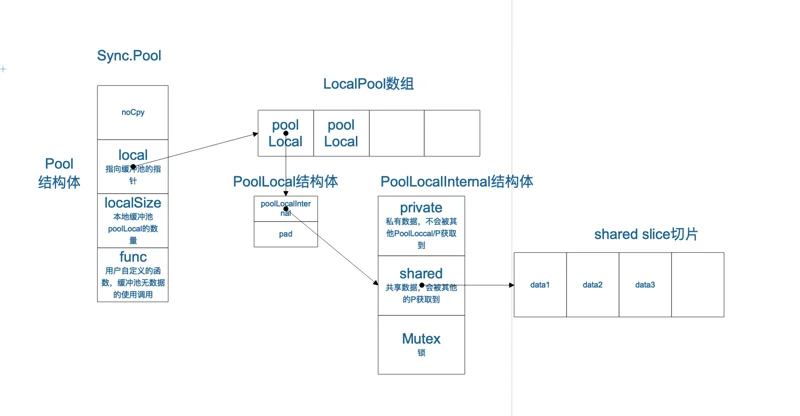sync pool使用来存放临时变量的一个缓冲区,但是这个缓冲区并不可靠,每次gc的时候,都会首先清除缓冲区,所以,假如一个slice仅仅存放在 Pool 中,而没有其他地方引用,则会被当成垃圾清理掉。
概念
A Pool is a set of temporary objects that may be individually saved and retrieved.
Any item stored in the Pool may be removed automatically at any time without notification. If the Pool holds the only reference when this happens, the item might be deallocated.
A Pool is safe for use by multiple goroutines simultaneously.
Pool’s purpose is to cache allocated but unused items for later reuse, relieving pressure on the garbage collector. That is, it makes it easy to build efficient, thread-safe free lists. However, it is not suitable for all free lists.
An appropriate use of a Pool is to manage a group of temporary items silently shared among and potentially reused by concurrent independent clients of a package. Pool provides a way to amortize allocation overhead across many clients.
An example of good use of a Pool is in the fmt package, which maintains a dynamically-sized store of temporary output buffers. The store scales under load (when many goroutines are actively printing) and shrinks when quiescent.
图示

sync.pool的结构组成如上图所示,在这里可能会有两个问题
- 我们实例化 Sync.Pool的时候,为什么实例化了一个LocalPool数组,怎么确定我的数据应该存储在LocalPool数组的哪个单元?
- PoolLocalInternal 里面的成员有private和shared,为什么要做这两种区分?
源码分析
Put
Put()
func (p *Pool) Put(x interface{}) {
if x == nil {
return
}
// race检测 先忽略这一块
if race.Enabled {
if fastrand()%4 == 0 {
// Randomly drop x on floor.
return
}
race.ReleaseMerge(poolRaceAddr(x))
race.Disable()
}
// 根据自身的goroutine的id,获取对应的PoolLocal的地址,后面具体分析
l := p.pin()
// 如果private字段为空的话,首先给private字段赋值
if l.private == nil {
l.private = x
x = nil
}
runtime_procUnpin()
// 如果private字段, 则添加到shared字段,因为 shared字段可以被其他goroutine获取,所以这里需要加锁
if x != nil {
l.Lock()
l.shared = append(l.shared, x)
l.Unlock()
}
if race.Enabled {
race.Enable()
}
}pin()
func (p *Pool) pin() *poolLocal {
// 获取当前的Pid/P,数量由
pid := runtime_procPin()
// LocalPool的数量
s := atomic.LoadUintptr(&p.localSize) // load-acquire
l := p.local // load-consume
// 如果获取到的pid比LocalPool数组的长度小,返回对应的LocalPool
if uintptr(pid) < s {
return indexLocal(l, pid)
}
// 如果pid比LocalPool数组的长度大,进一步确认,这个函数后面讨论
return p.pinSlow()
}runtime_procPin()runtime_procPin()runtime.GOMAXPROCS(0)PinSlow()
func (p *Pool) pinSlow() *poolLocal {
// Retry under the mutex.
// Can not lock the mutex while pinned.
runtime_procUnpin()
allPoolsMu.Lock()
defer allPoolsMu.Unlock()
pid := runtime_procPin()
// poolCleanup won't be called while we are pinned.
// 再次检查是否LocalPool是否有对应的索引,避免其他的线程造成影响
s := p.localSize
l := p.local
if uintptr(pid) < s {
return indexLocal(l, pid)
}
// 如果local为nil,说明是新构建的Pool结构体,加紧allPools slice里面
if p.local == nil {
allPools = append(allPools, p)
}
// If GOMAXPROCS changes between GCs, we re-allocate the array and lose the old one.
// 重新获取 GOMAXPROCS,并根据这个设置PoolLocal的大小
size := runtime.GOMAXPROCS(0)
local := make([]poolLocal, size)
atomic.StorePointer(&p.local, unsafe.Pointer(&local[0])) // store-release
atomic.StoreUintptr(&p.localSize, uintptr(size)) // store-release
// 找到当前goroutine对应的地址,并返回
return &local[pid]
}Put 逻辑
综上,Put的基本操作逻辑就是
PidPoolLocalPoolLocalInternalPoolLocalInternalprivatePoolLocalInternalsharedGet
Get()
func (p *Pool) Get() interface{} {
if race.Enabled {
race.Disable()
}
// 获取到LocalPool
l := p.pin()
// 把private数据值拷贝一份,然后把private设置为nil,因为如果private有数据,把private数据返回后,要把private设置为nil,如果private没有数据,则原先就是nil,添加这一步也没有关系
x := l.private
l.private = nil
runtime_procUnpin()
// 如果private里面没有数据,则从shared里面去找
if x == nil {
l.Lock()
last := len(l.shared) - 1
if last >= 0 {
x = l.shared[last]
l.shared = l.shared[:last]
}
l.Unlock()
// 如果当前线程下对应的LocalPool,没有数据,则调用getSlow(),从其他的LocalPool的shared里面获取数据,后面解析 getSlow
if x == nil {
x = p.getSlow()
}
}
if race.Enabled {
race.Enable()
if x != nil {
race.Acquire(poolRaceAddr(x))
}
}
// 如果 从private shared及其他的LocalPool的shared里面都获取不到数据,且注册的New函数不为空,则执行注册的New函数
if x == nil && p.New != nil {
x = p.New()
}
return x
}getSlow()
func (p *Pool) getSlow() (x interface{}) {
// See the comment in pin regarding ordering of the loads.
// 获取LocalPool的size
size := atomic.LoadUintptr(&p.localSize) // load-acquire
local := p.local // load-consume
// Try to steal one element from other procs.
pid := runtime_procPin()
runtime_procUnpin()
// 便利LocalPool,获取shared里面的数据,找到就返回
for i := 0; i < int(size); i++ {
l := indexLocal(local, (pid+i+1)%int(size))
l.Lock()
last := len(l.shared) - 1
if last >= 0 {
x = l.shared[last]
l.shared = l.shared[:last]
l.Unlock()
break
}
l.Unlock()
}
return x
}sharedprivatesharedpoolCleanup
这个函数是Pool包里面提供的,用来清理Pool的,但是官方的实现略显粗暴
func poolCleanup() {
// This function is called with the world stopped, at the beginning of a garbage collection.
// It must not allocate and probably should not call any runtime functions.
// Defensively zero out everything, 2 reasons:
// 1. To prevent false retention of whole Pools.
// 2. If GC happens while a goroutine works with l.shared in Put/Get,
// it will retain whole Pool. So next cycle memory consumption would be doubled.
// 便利所有的Sync.Pool
for i, p := range allPools {
allPools[i] = nil
// 遍历Pool里面的LocalPool,并清空里面的数据
for i := 0; i < int(p.localSize); i++ {
l := indexLocal(p.local, i)
l.private = nil
for j := range l.shared {
l.shared[j] = nil
}
l.shared = nil
}
p.local = nil
p.localSize = 0
}
// 清空allPools
allPools = []*Pool{}
}这个函数会在GC之前调用,这也就解释了官方的下面一句话
Any item stored in the Pool may be removed automatically at any time without
notification. If the Pool holds the only reference when this happens, the
item might be deallocated.
如果一个数据仅仅在Pool中有引用,那么就需要担心这个数据被GC清理掉
问题分析
针对于上面提出的两个问题,做一下简单的分析
我们实例化 Sync.Pool的时候,为什么实例化了一个LocalPool数组,怎么确定我的数据应该存储在LocalPool数组的哪个单元?
这里的LocalPool是根据不同的pid来区分的,保证private数据的线程安全,程序运行的时候可以获取到pid,然后使用pid作为LocalPool的索引,找到对应的地址即可
PoolLocalInternal 里面的成员有private和shared,为什么要做这两种区分?
privateshared参考文档
《sync.Pool源码实现》
《Go 语言学习笔记 – 雨痕》
